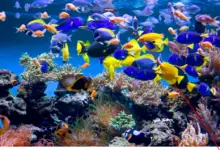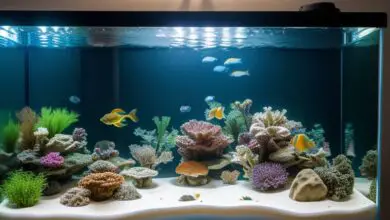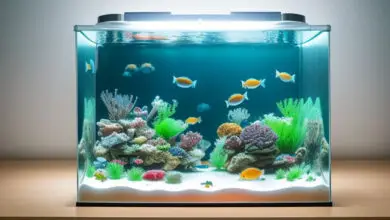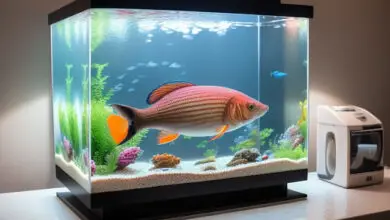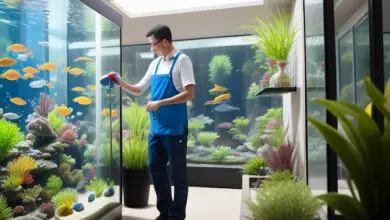Keeping Snails, Algae And Ailments Organically Checked

Having a freshwater aquarium can be a fun and relaxing hobby. However, sometimes issues can come up that negatively impact your tank inhabitants or appearance. Common problems include unwanted pest snails that rapidly multiply, algae blooms that take over plants, and infectious illnesses in fish. While medications and chemicals may seem the easiest solution, they can often cause unintended harm. This post explores handy alternatives to keep parasites, green plant growth, and diseases organically under control through prevention and gentle treatment options that are healthy for fish, invertebrates, and live plants.
Overview of Common Aquarium Pests
Some of the most prolific tank pests encountered are tiny snails and algae. When populations spike they can wreak havoc and overwhelm the stability of a small closed ecosystem. Both snails and algae naturally occur but an abundance of nutrients and lack of population control lets them thrive unchecked. The trouble is that chemical interventions like copper medicines impact creatures you wish to keep. It takes moderate effort to restrain the troublesome tank invaders already present and block new ones from entering on plants.
Goals of Gentle Control
Rather than deploying harsh wide-spectrum treatments to instantly wipe out blights, the aim is to curb increases early and avoid chemicals that accumulate. Medications like copper also damage essential filter bacteria that break down fish waste. An ounce of prevention saves gallons worth of grief down the line. Keeping populations low stems primarily from vigilance, proper tank care, and enlisting natural helpers to out-compete problem species.
Preventing Issues in the First Place
Being proactive is essential to avoid explosions of unwanted algae growth, bothersome snails, and sick fish. Starting out correctly makes maintaining balance much simpler down the road.
Quarantining Additions
Any living things added to a tank carry the risk of bringing in some hitchhikers. Prior to adding new plants, fish, or invertebrates to your main tank, keep them isolated 2-4 weeks in a separate holding system observing for signs of illness and pests. This period allows symptoms to emerge in smaller volumes that are cheaper to treat. If issues do occur, it prevents exposure of everything already living in your display. During the quarantine duration, remove any visible snails, eggs clusters, worms, etc.Introductions present the highest likelihood of inadvertently adding something undesirable you’ll later struggle to manage.
Provide Stable Conditions
Fluctuating water parameters stress organisms leaving them prone to health troubles. Test for ammonia, nitrites, nitrates, pH, carbonate hardness, and dissolved organic compounds. Adjust to reach the recommended levels for the particular species you are keeping. Use pH adjusting chemicals only when needed since altering acidity or alkalinity influences filtration and the equilibrium of other compounds in water. Perform routine partial water changes to reduce concentrations of water-soluble chemical waste like nitrates.
Moderate Feeding
Overfeeding provides an abundant food source that breeding pest species capitalize on. Only offer as much food as your fish, shrimp, and snails can completely finish within a few minutes 1-2 times daily. Uneaten remnants that sink and remain ultimately decay releasing more phosphates and nitrogen into water that nourishes algae.
Subdued Lighting
Intensity and duration of illumination necessitate careful control in aquariums to keep advantage-taking organisms under control. Use timer switches on light fixtures and aim for only 6 to 8 hours of daily exposure. For densely planted tanks or those incorporating living algae use the lower end of the range. Position intense light requiring plants directly under sources and shade lower areas.
Strategic Supplements
Augmenting carbon dioxide levels enables plants to uptake more nutrients from water limiting the surplus algae can use. But take care to maintain optimal dissolved CO2 concentrations for livestock health. Apply fertilizers leanly with more significant dosing following water changes and trim sessions when plants have increased demands.
Snail Population Explosions
Ramshorn, pond, Malaysian trumpet and bladder snails remain the most prolific infestations in home aquariums. Their numbers multiply rapidly because they reproduce prolifically, eating all kinds of foods. Getting control of established dense masses proves tricky, demanding successive efforts.
Removing Existing Snails
The first actions serve to thin out what is presently living in the tank through manual extraction and trapping. Search decor, plants and the waterline to identify all visible adult snails and eggs. Remove these during each week’s water change using lettuce wrapped weights set overnight to capture clusters crawling about after dark. Eliminating egg bundles avoids hundreds more eventually emerging.
Setting snail traps made from a bottom slice of plastic bottle, veggie clips or cleaned lettuce leaves picked through every few days decreases populations. Baiting the traps exploits their liking for tasty fruit and vegetable pieces like cucumber, zucchini and melon rinds. The dimpled skin of honeydew melons in particular attracts clinging masses. Promptly removing appealing traps disposes of considerable numbers before they reproduce again.
Block New Snail Introductions
Preventing more snails entering the ecosystem limits their spread. Quarantine and carefully examine newcomer plants and animals before allowing them to join the main tank. Hand removal of visible snails on plants using a bleach dip on hardier species also lowers risks. When adding anything live, expect some nearly microscopic snails and eggs get introduced so remain observant following additions for signs of new infestations. Isolate and treat anything suspicious separately.
Starve Them Out
Snails thrive if plentiful edible remains end up accumulating for them to eat so the best means to constrain growth relies on limiting food availability. Feed only as much as your fish and shrimp completely consume right away without leftovers several times a day. Manually remove dying leaves with softened cellular structures before they begin decomposing. Thorough gravel vacuuming during water changes sucks up edible organic debris and baby snails developing in the substrate. Persistently reducing nutrients available to scavenge eventually stabilizes populations.
Managing Algae Growth
Just as with animals, algae naturally occurs within tanks too, contributing to the overall balance. But when their numbers exponentially increase, green plant life takes over crowding out what you wish to cultivate. Recognizing what type has cropped up and altering conditions that facilitate its spread keeps growth constrained.
Identify Algae Types
Accurately identifying specific varieties appearing allows responding with the most effective control methods. Green hair algae grows in flowing water currents. Cynobacteria blue-green slime coats surfaces in organics rich conditions. Green spot algae dots older leaves. Diatoms form rusty brown colored films. Recognizing the type presents clues about underlying causes to address like high iron, silicates, waste levels or poor water movement.
Manual Removal
Your first line of attack revolves around manually eliminating algae through direct wiping, scraping, pruning and appropriate tank creature grazing. Use soft cloths, plastic scrub pads and algae eliminating magnets on glass. Prune severely affected leaves. Toothbrushes serve handy for scrubbing decor items. Repeatedly extracting visible growth with each recurrence limits its anchoring hold and diffusion. Let algae consuming fish and invertebrates nibble away what they can too.
Test and Adjust Parameters
Checking chemical levels within the water frequently helps avoid precipitating algae promoting conditions. Nitrates and phosphates, in particular, offer nutrients that feed algal growth. The majority stems from fish waste and decaying organic material. Counteract rising reservoirs with judicious water changes, gravel cleaning and filter media rinsing targeting reduction. Light and CO2 influence plant and algae growth too. Moderate bright intensities reaching established plantings and maintain sufficient carbon dioxide for growth needs.
Deploy Algae Eating Crews
Purposefully choosing algae grazing creatures assists considerably in keeping furry green growth trimmed back. Common primable options include Siamese Algae Eater fish, rabbit snails, nerite varieties, bamboo and vampire shrimp plus Ostrecocus catfish. ForHair algae, consider amano shrimp or Crossocheilus siamensis fish. Be mindful of livestock compatibilities and tank size, only adding what is suitable.
Recognizing and Treating Common Fish Illnesses
Sometimes despite best efforts, fish still occasionally fall ill. Catching problems early and accurately identifying the likely cause guides providing the right remedy. Home treatment methods often resolve many common aquarium fish diseases without harsh medications.
Ich (White Spot Disease)
Tiny white grains resembling sprinkled salt appear on fish akin to grains of icing sugar. Flashing, when fish rub up against objects, and loss of appetite accompany spotting.The unicellular ciliate parasite replicates fastest in temperatures between 64-75°F. Raise heat to 86°F to speed its life cycle and kill tomonts, the reproductive stage. Remove activated carbon filtration during treatment to avoid removing remedial chemicals. Apply standard aquarium salt at 1 tbsp per 5 gallons and methylene blue or other ich medication alongside elevated temperature for full course. Water changes help strip parasites without reintroducing new pathogens during treatment.
Fungus and Fin Rot
Fungus growth looks like white cottony tufts on fish while fin rot shows ragged deterioration of edges. Both stem from opportunistic bacterial and fungal infections attacking tissue already showing damage from poor water quality, mishandling or wounds. While antibiotics treat stubborn cases, mild signs often resolve through clean conditions and antiseptics alone. Add Indian Almond leaves releasing beneficial tannins and methylene blue at manufacturer recommended dose to inhibit further fungal growth and infection spread. Reduce ammonia and nitrites by increasing water replacement frequency.
Unwanted Pests Like Planaria, Leeches and Scutariella
Microscopic worms gliding across glass or substrate and blood sucking ectoparasites latching onto fish characterize some rather unpleasant tank passengers. They typically arrive on new plants added without quarantine. Removing by hand whenever noticed and using foods designed to eliminate internal parasites works to steadily eradicate populations without resorting to dog dewormer spot treatments better suited for predatory reptile habitats. The stomach and intestine dwelling hexamita also infected guppies and other small species, causing sporadic deaths that can be cured with metronidazole soak fed foods.
Employing Natural Predators
Certain fish and invertebrates chomp through hordes of snails or outcompete nuisance algae. Strategically adding them to established tanks helps considerably lessen the burden of pests without relying on pesticides.
Snail Eating Fish
Several fish make a meal of small snails, effectively keeping numbers down through natural predation. Most Loaches, particularly clown and yoyo varieties, actively hunt smaller ramshorn and bladder varieties during the night. Pufferfish also pursue snails as preferred fare but require specialized brackish water parameters. Bettas and goldfish may nip and eat smaller snails while juvenile assassins and pea puffers attack bigger pond and ramshorns.
Cleaner Crews
Tank janitors like shrimp and algae grazing fish naturally chomp through hair-like growth and detritus limiting blooms and waste accumulation. Shrimp varieties including Amanos, Ghost and Bamboo Shrimp feeds heavily on hair algae and aufwuchs coating on decor. Several small catfish like otocinclus and bristlenose plecostomus rasp green spot algae and biofilm. Nerite snails crawl over surfaces slurping green spot and diatom algae through their noodle-like mouth. Adding a cleanup crew duo that prefers the same water parameters tackles maintenance needs and serves as fallback food if populations decline.
Herbal Treatments and Remedies
Traditional approaches used for human maladies adapt well to managing fish illness gently. Simple salt baths work wonders soothing fungal infections on body and fins. Dissolve 1 tbsp salt per gallon of tank water in a quarantine container for a five-minute dip that aids healing before returning fish to the main tank. Garlic offers natural antimicrobial and antifungal boosting properties as well when soaked then fed in gel food recipes. Indian Almond leaves infuse antibacterial compounds from released tannins that curb fungal and bacterial spread while encouraging beneficial biofilm growth. Let leaves steep two weeks then use the resulting concentrate as a remedial bath at 5% solution for ten minutes before returning fish to home water.
Concluding Thoughts
Keeping nuisance snails, problematic algae and common fish diseases in check without relying solely on strong chemical interventions comes down to vigilant tank maintenance and early intervention. Concentrating on prevention helps avoid playing catch-up with huge pest snail reproduction and algae overgrowths down the line. Manual removal, conditions adjustments and choosing natural predators provide gentle means to get populations under control when they crop up. Catching and properly identifying sickness early allows home treatment methods to work most effectively as well. Using several complementary approaches helps curb common freshwater aquarium issues keeping your tank inhabitants and plants happily thriving long-term.

